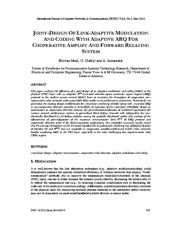A copy of this work was available on the public web and has been preserved in the Wayback Machine. The capture dates from 2018; you can also visit the original URL.
The file type is application/pdf.
Joint-Design of Link-Adaptive Modulation and Coding with Adaptive ARQ for Cooperative Amplify and Forward Relaying System
2016
International Journal of Computer Networks & Communications
This paper analyzes the efficiency of a joint-design of an adaptive modulation and coding (AMC) at the physical (PHY) layer with an adaptive R max -truncated selective-repeat automatic repeat request (ARQ) protocol at the medium access control (MAC) layer to maximize the throughput of cooperative nonregenerative relay networks under prescribed delay and/or error performance constraints. Particularly, we generalize the existing design model/results for cross-layer combining of AMC along with
doi:10.5121/ijcnc.2016.8314
fatcat:qxutotdshva2lh5f5iprg4rrny

